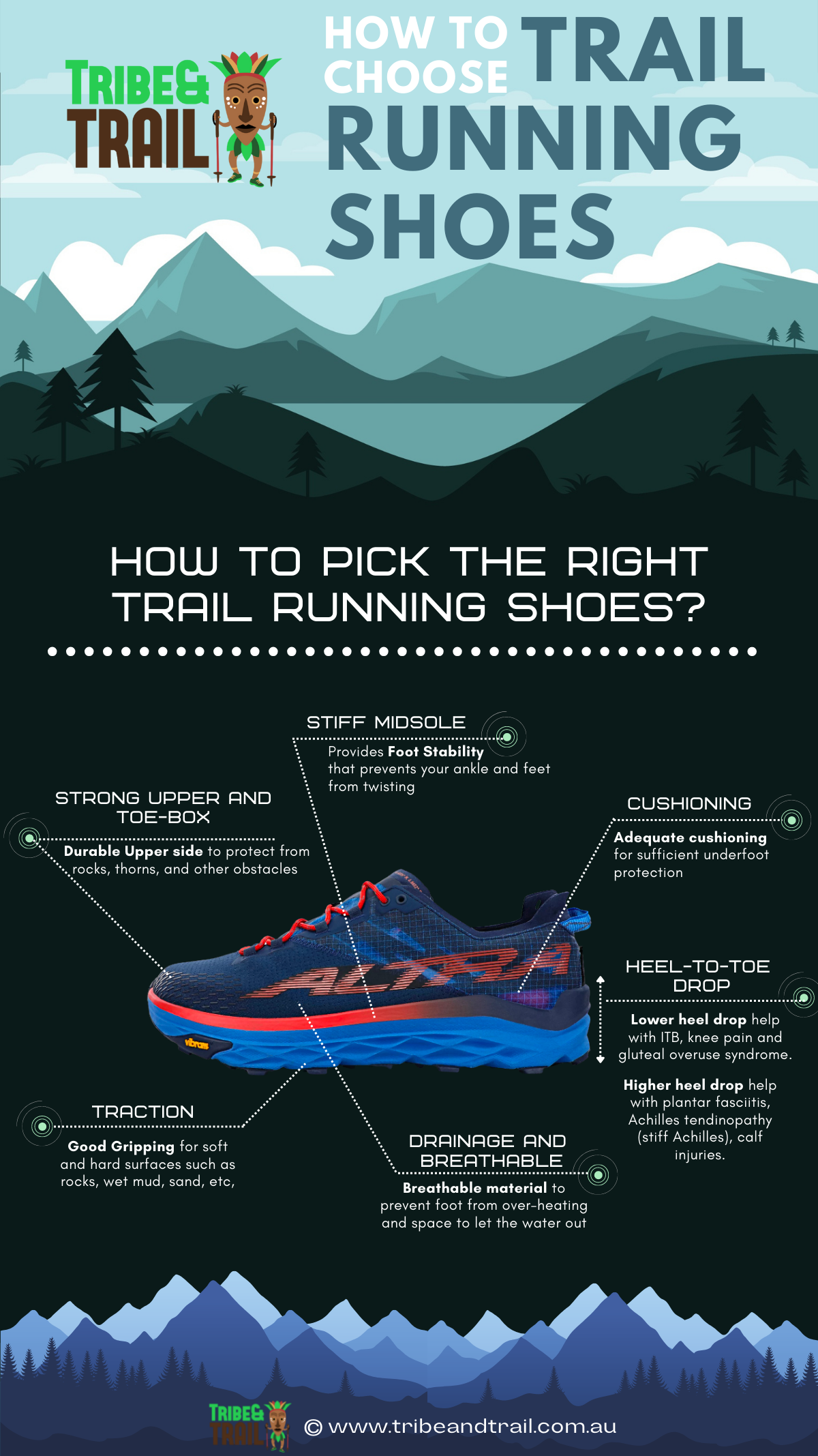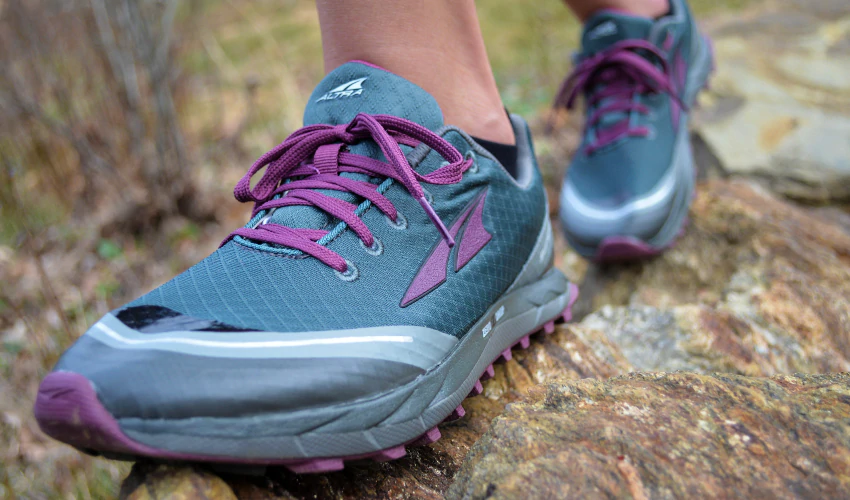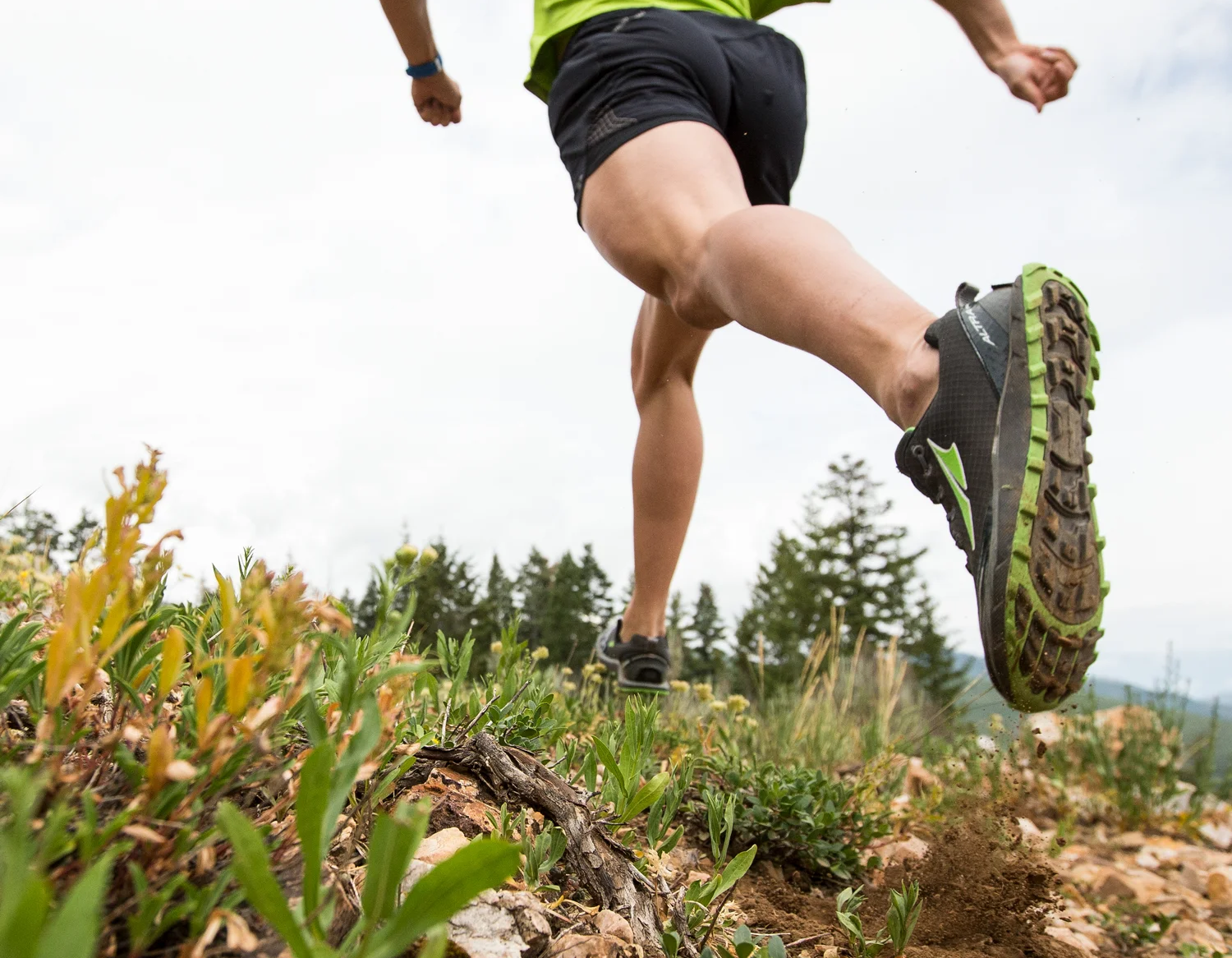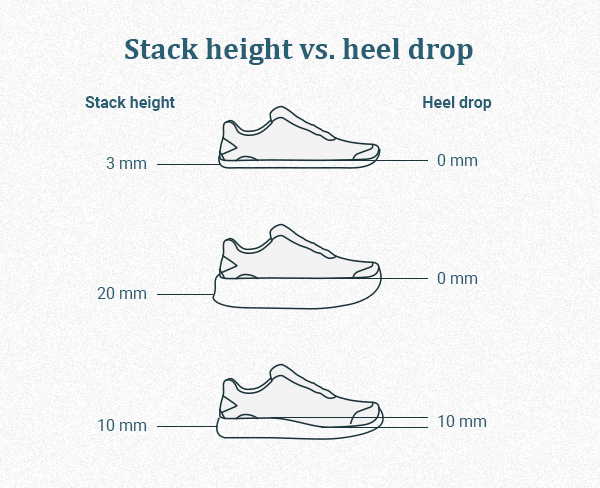How to Choose Trail Running Shoes?
If you're new to trail running, the first and the most important gear that you would need is a trail running shoe to start your new running experience. The prospect of choosing the right trail running shoes can be daunting. But don't worry, we're here to help!
This guide on how to choose trail running shoes will answer some of the most common questions for trail running beginners when choosing trail running shoes such as what are trail running shoes? how to choose trail running shoes? how long do trail running shoes last? what size trail running shoe should I buy? And where to buy trail running shoes in Australia?
|
This trail running shoes guide covers 6 topics to help trail runners decide on the best shoes to buy:
|
This guide on trail running shoes is part of our series: Intro to Trail Running
If you are new to trail running, check out our
Beginners Guide to Trail Running
What are Trail Running Shoes?
Trail running shoes are designed to handle rough and rugged trail terrain where you run through mud, rocks, debris, sand, water, or any other obstacles. Trail runners have more durable soles for protection against these obstacles and offer a stiff midsole that provides you extra stability while running on uneven surfaces
Trail runners have more durable outsoles and are more aggressive than normal running shoes to offer you better traction on the trail. They also have a higher ankle collar to protect your feet from debris and rocks. And most importantly, they are breathable to keep your feet cool and dry in hot weather conditions.

Generally speaking, Trail running shoes are different from road runners or regular running shoes in various aspects:
Traction (Grip): Trail shoes come with lugged soles that improve traction and help you move comfortably over debris, mud, rocks, gravel, or even wet and slippery surfaces.
Foot protection: You are often exposed to sharp objects such as rocks, thorns, and other obstacles. Trail runners come with certain internal and external features that shield your feet from such obstacles without getting torn or damaged.
Stiff construction and Stability: Trail running shoes come with a stiff midsole that is built to prevent excessive foot rotation. Trail running involves relatively shorter steps with irregular and dynamic strides because you constantly adjust your foot at the most optimal position on the land. Hence, your feet require more stability while running on trails.
Read More: Best Trail Running Shoes for Men in 2022
Read More: Best Trail Running Shoes for Women in 2022

Types of Trail Running Shoes
How to choose trail running shoes starts by understanding the type of trails you are planning to run on. There are different types of trail terrains starting from easy-to-run groomed terrains to difficult and rugged technical terrains. This trail running shoes guide would help you find a shoe that would be suitable for the trail of your choice.
Trail-running shoes fall within three broad categories:
Light Trail Shoes
Light trail running shoes are designed for soft surfaces like groomed dirt trails and packed gravel. They generally have a rubber outsole with small, widely spaced lugs for traction. The uppers on light trail shoes are often made of mesh to keep them light and breathable, and they usually don't have as much protection around the toes and ankles as shoes for rugged trails.
Light Trail Shoe Characteristics
- Descend protection from obstacles such as rocks and roots
- Lightweight trail running shoes are designed to maintain a fast pace
- Moderate stiffness to enable stable foot placement
- Shallow lugs that offer enough grip on packed soil
If you mainly run on gentle to moderate trails with good footing, light trail shoes are a good option. Light trail shoes provide good cushioning, support, and traction without being too heavy or bulky, making them a good choice for versatile performers who want to go fast on the trails.
Rugged Trail Shoes
Rugged trail running shoes are designed for more challenging terrain, including rocky, root-filled trails and loose, sandy, or muddy surfaces. They have a thicker outsole with deeper lugs for traction, and the uppers are often made of leather or synthetic leather for durability and protection. Rugged trail shoes may also have a waterproof or water-resistant coating to help keep your feet dry in wet conditions. If you run on hilly, technical trails or in wet weather, rugged trail shoes are a good choice.
Rugged Trail Shoe Characteristics
- An aggressive outsole tread pattern for traction on varied surfaces
- Strong materials and a rock plate to protect the foot against sharp obstacles, rocks, and thorns
- Stiff midsole cushioning to absorb footfalls on hard surfaces and steep downhills
- A waterproof and breathable upper to keep the foot dry
- A low-profile design for stability on uneven terrain
Rugged trail shoes are typically heavier than other types of running shoes, but they provide the protection and stability needed to tackle the most difficult trails. Whether you’re tackling technical singletrack or exploring an off-the-beaten-path gulch, rugged trail shoes will help you get the most out of your run.
Off-Trail Shoes
For the adventurer who wants to explore beyond the beaten path, off-trail shoes are a must. Off-trail shoes are designed for running in deep snow or sand. They have a wide, flat sole with large lugs or studs for traction, and the uppers are often made of water-resistant materials.
Off-Trail Shoe Characteristics
Off-trail shoes offer all of the same features as rugged-trail shoes - good traction, durable construction, and support for uneven terrain - but with a few added benefits.
- First, off-trail shoes typically have higher ankle support to protect against rolled ankles.
- Second, they often have a water-resistant or waterproof coating to help keep your feet dry in wet conditions.
- And finally, they often feature an extended toe box to give your toes plenty of room to move and flex, preventing blisters and hot spots.
So if you're looking to take your trail running to the next level, off-trail shoes are the way to go.

Shoe Cushioning
There is a wide range of trail running shoe cushioning options available to runners, from shoes with no padding whatsoever to shoes with massively cushioned midsoles. The level of cushioning, often referred to as stack height, can have a big impact on a runner's experience.
Shoes with more cushioning tend to provide a "bouncy" feeling, while those with less cushioning allow for a more manual experience and connection with the ground.
Ultimately, the right level of cushioning for any given runner is a matter of personal preference. Some runners prefer the added protection and comfort that comes with more cushioned shoes, while others find that too much-cushioning gets in the way of their enjoyment of the run. Experimentation is key in finding the right trail running shoe for you.
When choosing trail running shoes, it's also important to consider the type of terrain you'll be running on. If you're planning on doing a lot of running on softer surfaces like dirt trails or grass, you'll want a shoe with a more cushioned feel. However, if you're going to be doing mostly running on harder surfaces like rocks or roots, you might want to opt for a shoe with less cushioning in order to feel the ground beneath your feet and maintain good traction.
Heel-to-Toe Drop
When choosing trail shoes, it’s important to keep the heel-to-toe drop in mind. This feature is closely related to cushioning height of the shoe. The heel-to-toe drop is the difference between the height at the heel and the height at the forefoot and they can range from 0mm to more than 12mm.

Based on a heel-to-toe drop, trail running shoes are divided into 4 categories:
- Zero drop shoes (0mm)
- Low drop shoes (1-4mm)
- Mid drop shoes (5-8mm)
- High drop shoes (8+ mm)
| Low-Drop Shoes (0 mm - 4 mm) | High-Drop Shoes (5 mm - 8+ mm) |
|---|---|
|
|
|
| Lower heel-to-toe drop has a great potential to improve cadence. | Higher heel-to-toe drop trail shoes have a slower foot switch |
| Zero drop and lower heel-to-toe drop shoes promote better mid-foot and forefoot strike. | Higher heel-to-toe drop promotes rear-foot strike because the raised heel assists with ground impacts when the foot hits the ground. |
| Lower and Zero drop shoes may help with ITB, gluteal overuse syndrome, and anterior knee pain. | Higher drop shoes may help with Achilles tendinopathy (stiff Achilles), plantar fasciitis, and calf injuries. |
|
Low heel-to-toe drop shoes promote ankle flexion during foot strikes. The ankle assists with ground impact and works as a shock absorber.
But these shoes may put some stress on the ankle, foot, and lower leg. |
High heel-to-toe drop shoes promote higher knee flexion. But high drop shoes may have the potential to stress the hips and knees more. |
Trail Running Shoe Fit
How should trail running shoes fit is more important than any other factor when choosing trail running shoes. A trail running shoe that has great reviews might not be the best shoe for you if it doesn't fit your foot.
How a trail running shoe should fit includes many more considerations than length and breadth. Feet shape may vary from person to person, and a good trail shoe fit would take into account certain foot characteristics such as arch length, arch shape, foot volume, and others.
If you have high arches, you'll need a trail shoe with more cushioning. If you have flat feet, you'll need a trail shoe with more stability.
Another important aspect to consider while choosing trail running shoes is the width of the shoe. If you have wider feet, you'll want to make sure to choose a trail running shoe that accommodates that. Otherwise, you might end up with shoes that are too tight and cause blisters or other issues.

Additional Tips on How to Choose Trail Running Shoes
Now that you know what are trail running shoes and how to choose trail running shoes, it's time to find the right pair for you. Here are some additional tips you should consider while choosing trail running shoes.
Know your trail terrain
When choosing trail running shoes, it is also important to consider what type of trail terrain you are planning to run on. Are you going to be running on groomed trails or technical trails? Groomed trails are easier to run on and don't require as much grip or protection. Technical trails are more difficult to run on and require more grip and protection.
If you're planning on doing a lot of running on easy and softer surfaces you would need a trail shoe with more cushioning. However, if you're going to be doing mostly running on harder surfaces like rocks or roots, you might want to opt for a trail shoe with less cushioning in order to feel the ground beneath to maintain good traction.
Choosing trail running shoes for your foot type
You need to choose the right trail running shoes for your foot type. In this trail running shoes guide, we've already explained to you how should trail running shoes fit. And it is very important for you to know your foot shape and type to find the right trail shoe fit.
If you have high arches, you'll need a trail shoe with more cushioning. If you have flat feet, you'll need a trail shoe with more stability. If you have wider feet, you'll want to make sure to choose a trail running shoe that accommodates that. Otherwise, you might end up with shoes that are too tight and cause blisters or other issues.
Don’t assume you know your shoe size
Your foot shape gradually changes as you get older, so it's always a good idea to get them measured once in a while. You might also have to consider the fact that your feet may swell as you run due to various reasons, hence your shoes must have adequate length and width in the toe box.
Should trail running shoes be a size bigger?
When it comes to size, it's generally recommended that you buy trail running shoes that are about a half size larger than your regular street shoes. This is because when you're running, your feet tend to swell and you don't want your shoes to feel too snug.
If you're just starting out, it might be a good idea to buy your trail running shoes from a store so that you can try them on and make sure they fit well. Once you know what kind of shoe you like, then you can start shopping around for the best deal online.
Pick the right trail running shoes for the weather
You might need to consider the type of weather around the trail area while selecting the right trail running shoes. If it's going to be wet, you'll need a trail shoe with good drainage. If it's going to be cold, you'll need a trail shoe that's insulated.
How long do trail running shoes last?
If you are thinking about how long do trail running shoes last? Then you must make your best guess: If you are planning to run regularly, a new pair of running shoes would last 4 to 6 months.
Where to Buy Trail Running Shoes in Australia?
Now that you know how to choose trail running shoes, it's time to go buy some! Here at Tribe&Trail, you can browse through our collection of the best trail running shoes in Perth, Australia.
You can find the top performance and durable shoes for trail running on our website from top brands such as Altra, Topo Athletic, Dynafit, Kailas, INOV8, Tarkine, The North Face, and many more.
|
Shop Trail Running Shoes |
We hope you found this trail running shoe guide helpful. Happy trails!

![How to Choose the Best Trail Running Shoes [Buying Guide] How to Choose the Best Trail Running Shoes [Buying Guide]](https://cdn11.bigcommerce.com/s-a12530yfk6/images/stencil/1800x1800/uploaded_images/how-to-choose-trail-running-shoes.png?t=1655003871)








